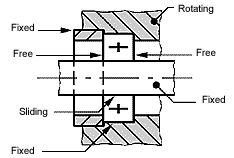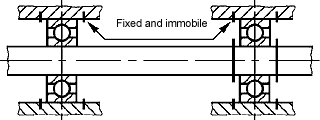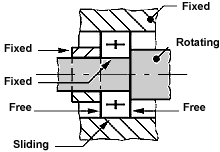Under the action of a radial loading, rotational bearings have a
tendancy to turn against their housings or shafts, which can cause
premature wearing of the aforementioned componants. Therefore, the
bearings must be fixed to the other elements of the assembly (shafts or
housings), so that they become an integral part of the system
RULE: A bearing ring which rotates in relation to the
movement of the load must be installed solidly. A bearing ring which
rotates with the load movement must be free.
Rotation of the
bore with respect to the loading
 |
 |
Rotation of the bore with respect to the loading
 |
 |
shaft-type of bearing |
||||||||
methods for rings |
C/P |
Shaft ?/B> | ball bearing |
roller bearing |
Spherical Roller bearing |
Bore | Observations | Examples of use |
| Fixed inner rings | weak >10 |
<40 40-140 140-200 |
h6 j6 k6 |
j6 k6 m6 |
j6 k6 m6 |
H7 | Movement of
the outer ring is easily possible |
Small
electric motors; machine - tools; ventilators, pumps; common mechanics |
| normal >5 <10 |
<40 40-140 140-200 |
j6 m6 |
k6 p6 |
k6 p6 |
H7 | General
mecanics; Electric motors; reducing gearboxes | ||
| high <5 |
<40 40-140 140-200 |
- - - |
n6 p6 p6 |
n6 p6 p6 |
J7 | Movement of
the outer ring is still possible |
laminators; large compressers. | |
| Fixed outer rings |
weak >10 |
all ?/FONT> | g6 | K7 - M7 | Movement of
the outer ring is impossible The inner ring can be displaced axially. |
Loose
wheels; transport rollers | ||
| normal >5 <10 |
all ?/FONT> | g6 | N7 | pulleys; rod ends load bearing wheels | ||||
| high <5 |
all ?/FONT> | g6 | P7 | pulleys; rod ends load bearing wheels. | ||||